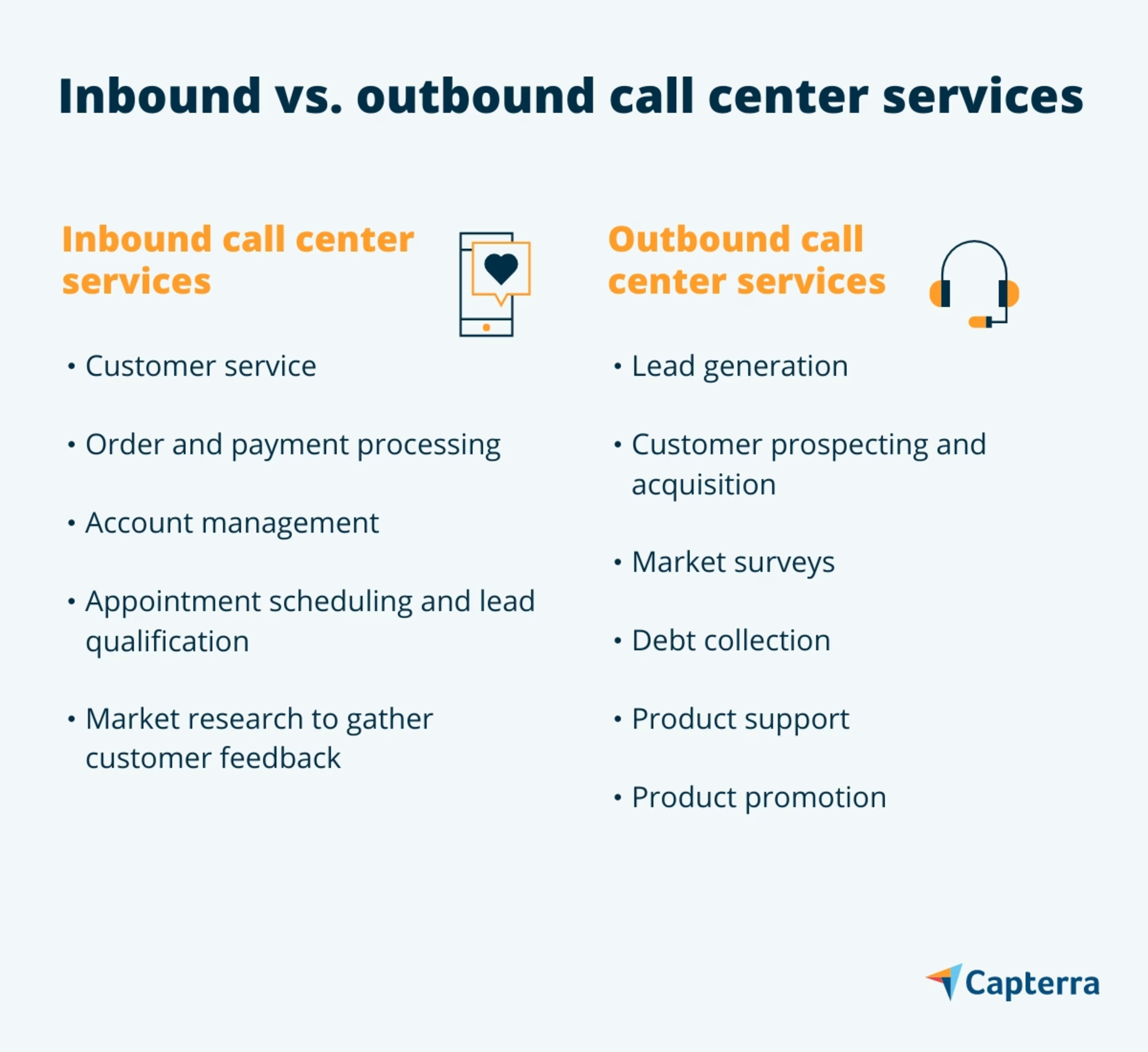Do you need an outsourced solution to handle incoming and outgoing call volume?
Call centers and contact centers can be extremely lucrative business units when properly leveraged by small business owners and entrepreneurs. Call centers help to introduce improved efficiencies and opportunities to grow the bottom line, as long as the type of call center strategically aligns with the operating model of the business.
To determine the type of call center that will best support growth and profitability in your small business or startup, it's necessary to understand which business processes are best supported by inbound call centers support versus those best supported by outbound call centers, where there is overlap, and how an outsourced hybrid solution might be the strongest choice.
What is an inbound call center?
Inbound call centers are specialized customer service-focused business units deployed by businesses that receive more inbound call traffic than their staff can practically handle and still perform their job functions. Callers often seek answers to questions or desire problem resolution. Inbound call centers are fielding incoming phone calls from existing customers, fellow employees, or potential leads interested in the business’s services or products.
Inbound call center services
Inbound call centers are able to support multiple business processes at a time, with call center agents at inbound centers primarily focused on handling service-related tasks.
Customer service
Inbound centers are often tasked with fielding customer service requests, resolving complaints about a product or service, or acting in a technical support capacity. More than half of retail customers who feel their issue is urgent prefer to resolve their issue over the phone with a live agent.[1]
Order and payment processing
In the early stages of a startup or small business, it’s common to handle sales and payment processing in-house. As the business grows over time, however, your volume of sales will reach a point where your sales department will become overwhelmed with the volume of inbound calls. When focused on order and payment processing, inbound call centers can provide an alternative sales channel to eCommerce platforms.
Whether outsourced or handled in-house, order and payment-focused inbound call centers help increase sales for businesses by providing 24/7 access to capture customers seeking to purchase products and services outside of normal operating hours. A 2020 survey of consumers revealed that 87% of respondents preferred talking to a sales agent on the phone for high-consideration purchases rather than making the purchase via an online platform.[2]
Account management
Customer relationship management (CRM) tools are heavily leveraged by call center agents to track customer interactions. This makes inbound call centers ideal touch points for customers seeking to make changes to their services, manage payments, and other account-related activities. Because CRM tools often integrate multiple channels of communication, call centers become crucial for maximizing customer lifetime value (CLV).
Appointment scheduling and lead qualification
Once a potential customer engages with your call center to inquire about products or services, your call center agents can assess if the caller matches up with your ideal customer profile (ICP). If your call center agent is able to qualify a lead against your ICP, the agent can focus their sales efforts on the conversion of the caller by setting up an appointment with your sales team.
While inbound strategies are growing in popularity, 44% of sales representatives don’t feel these leads are qualified enough to effectively convert.[3] With an effective lead qualification cadence, your team can direct callers who aren’t a good fit with your ICP towards informational content on the inbound marketing funnel that might help move them closer to becoming a customer in the future and make it easier for your sales team to convert.
Performing market surveys to gauge demand for new services or products
Unlike cold calls or outbound surveys, inbound market research is initiated after a caller interacts with a service or product and accepts an invitation to connect with your customer service agents. Inbound market surveys, often targeted at identifying whether potential new products or services resonate with a target audience, are a huge opportunity that many call centers aren’t taking advantage of. Studies show only 38% of contact centers invite customers to engage in a survey following contact.[4]
Call center market research for customer feedback collection: Market research conducted by inbound call centers includes fielding inbound contact from customers to gather feedback about the service they’ve received, their experience with your products, or their assessment of the services they’ve received.
Call centers gather suggestions from leads and customers: To increase brand perception and customer loyalty, it’s important that leads and customers feel comfortable making suggestions for improvements to your existing products or services. This can be folded into customer market surveys as well as invitations to provide feedback.
What is an outbound call center?
Outbound call centers are business units or stand-alone facilities built to support external customer service-focused business processes such as sales, accounting, and ongoing customer support. Outbound call center agents are increasingly being leveraged proactively to make outgoing calls to both potential leads and existing customers.
Outbound call center services
Outbound call centers provide a balance against inbound marketing campaigns by actively engaging with leads and existing customers. This outreach encompasses a wide range of business processes.
Lead generation
Inbound lead generation is increasingly popular, but businesses still require the support of traditional call center activities such as cold and warm calling as well as direct telemarketing efforts. Generating leads through outbound call centers is becoming increasingly difficult as regulations to protect consumers are introduced at the state and federal levels.
/ Keep in mind
Some of the considerations call centers must keep in mind while generating leads as their business grows include:
Understand the times of day customers can be contacted legally in each state in which they operate.
Research what information must be included in messages, including the company name, the name of the caller, an active phone number, and steps that can be taken to request removal from future outreach.
Follow the National Do-Not-Call Registry.
Your number must be visible on the caller ID.
For further information, you should consult the Telephone Consumer Protection Act (TCPA) and the Telemarketing Sales Rule (TSR), as well as any industry- or state-specific regulations and laws that might exist in the states where you do business.
Customer prospecting and acquisition
Despite how aggressively phone communication is regulated and protected for consumers, 59% of consumers prioritize phone communications as their preferred point of contact.[5] Outbound call agents are able to contact prospective customers, who have opted to be contacted, and focus their sales efforts on lead conversion.
These lists of customers are gathered through forms and landing pages across the inbound marketing funnel or purchased from other opt-in sources. These lists contain enough information about the potential customer to determine if they align with your organization’s ICP.
Market surveys
With consumers prioritizing phone as a channel of communication, it follows that one of the leading priorities of outbound call centers is to perform market surveys. Rather than the limited reach and scope of customers who can be reached by your sales department or in-house customer service, call centers can reach a large number of customers quickly and gather survey data at scale.
Beyond tracking call center-centric metrics such as customer satisfaction scores (CSAT) and other performance metrics, the data gathered by market surveys can be turned into actionable insights to craft successful sales and marketing campaigns. With the help of outbound call centers, businesses can:
Identify new markets and demographics where your products or services will be in demand.
Identify industry trends that can be capitalized upon to deliver your products or services at the right time to the right audience.
Measure the demand for new products or services in your industry niche.
Gather customer perception and feedback in order to repair your brand reputation and strengthen your brand against challenges you might be facing currently or in the future.
Debt collection
Debt collection as an industry was valued at $20.9 billion in 2023, so it follows that call centers play a huge role in the practice of collecting payments from debtors in order to keep up with the volume of business.[6] Because of the nature of the outreach that they perform, debt collection-focused call centers must take extra care in adhering to the regulations that govern outbound calling, so as to not be penalized.
Despite the growing reliance on automation tools in call centers focused on other industries, debt collection call center agents contact debtors directly and prioritize empathy in order to humanize the collection process. This allows the debtors to communicate clearly and transparently to maximize their ability to successfully resolve debt accounts.
Product support
Maintaining a customer database of active product users or service subscribers allows your company to task your call center with carrying out proactive outreach campaigns. This can be especially useful when product issues arise or new features or services are available to existing customers, as it can decrease the volume of inbound calls from frustrated or angry customers.
Product promotion
Similar to the approach taken to support products and services, call centers can task outbound call agents to promote new products and services to customers that have been vetted as fitting a specific ICP. Outbound product promotion is also helpful to cross-sell and boost customer loyalty by providing existing customers with more reasons to patronize your brand.
Inbound vs. outbound call center
In choosing the right call center for the business, leadership should follow much of the same decision-making process as they would in deciding whether or not to outsource a specific business process. Whether choosing to invest in the infrastructure and staff to host a call center in-house or to outsource the process, it’s necessary to assess which call center functions are mission-critical to the brand’s success, thus determining where to focus the investment of time and resources.

Choose the call center format that will maximize your ability to connect with your customer base
While we’ve referenced data above showing consumers do prefer phone communication as a point of contact, the digital era in which we live has opened many paths of communication through which consumers now communicate with businesses, such as email, chat, SMS/text, video, and self-service through a website or mobile application.
While a call center would assist with either inbound or outbound communication, a more efficient method for small businesses to handle the multiple channels of incoming and outgoing communications would be to outsource these business tasks to a centralized contact center. Unlike the limited scope of a call center focused only on phone lines, centralized contact centers are capable of scaling their services to your specific customer base and volume of business while fully supporting inbound and outbound communications across your digital platforms.
Measuring the success of your call center strategy
Whether you’re looking to manage call center operations in-house through the purchase of a software platform or outsource call center operations to a call center service provider, Capterra has the resources you need to connect with agencies and software vendors to accomplish this. Capterra’s directories can connect you to:
What type of call center is right for your business?
Small business owners must understand how mission-critical it is to have the ability to effectively handle both inbound and outbound calls, and it’s important to decide whether to focus efforts on building out one or the other as an in-house business process or keep staff and resources fluid by outsourcing these tasks to a professional service provider.
Check out some of these additional Capterra resources that will help you find the right tools to support your approach to call centers:

